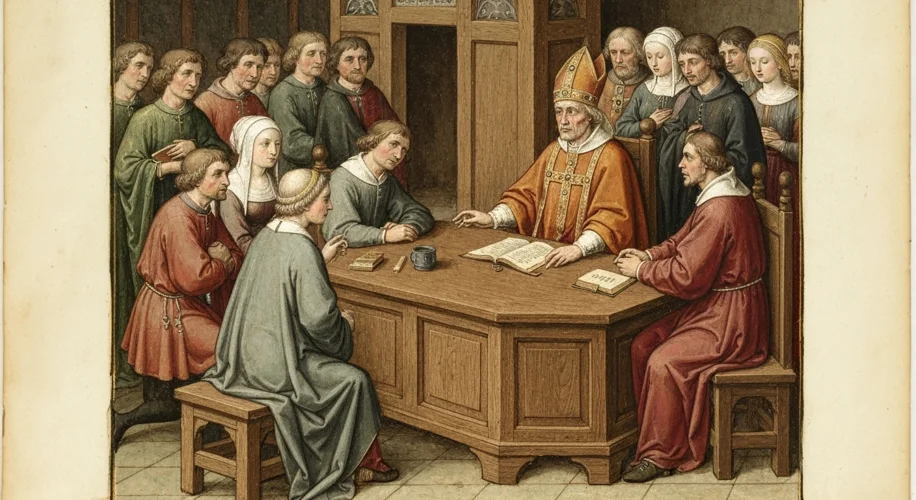In the hushed halls of ancient church courts, where matters of faith, morality, and community were decided, the testimony of witnesses held immense weight. But what was the standing of a woman’s word? Did she stand on equal footing with men, or was her voice diminished by the societal norms of the time?
The examination of female witnesses within Church Canon law reveals a complex tapestry woven with threads of reverence, suspicion, and evolving legal thought.
A World of Unequal Voices
To understand the role of a female witness, we must first cast our minds back to a world vastly different from our own. In many historical periods, particularly during the formative centuries of Church law (roughly from the 4th to the 12th centuries), societal structures placed women in a subordinate position. Patriarchal systems were deeply entrenched, influencing everything from property ownership to legal testimony. The prevailing view, often rooted in interpretations of scripture and philosophical traditions, tended to view women as more susceptible to emotion, less rational, and therefore, potentially less reliable as witnesses.
However, the Church, while often reflecting societal views, also possessed its own theological framework that could elevate women. Figures like the Virgin Mary and various female saints occupied positions of immense spiritual authority. This created an inherent tension: how could a society that revered Mary also distrust the testimony of ordinary women?
Canon Law: Navigating the Testimony of Women
Early Church Fathers and legal scholars grappled with this question. The Decretum Gratiani, a monumental compilation of canon law from the 12th century, served as a cornerstone for centuries. Within its vast collection of canons, pronouncements, and scriptural interpretations, the issue of female testimony was addressed, often with a degree of caution.
Generally, canon law distinguished between different types of testimony. In cases of public crimes or matters of grave importance, the law often favored the testimony of multiple witnesses, particularly men. This was partly a reflection of the belief that a single woman’s testimony might not be sufficient to establish the truth. Gratian, for instance, in his discussions on evidence, cited passages that seemed to limit the weight of a woman’s word, echoing a sentiment found in Roman law where women’s testimony was sometimes restricted.

However, it would be an oversimplification to say that women were entirely excluded. In certain contexts, particularly in cases involving marriage, dowry, or matters specifically pertaining to women’s lives and domestic spheres, their testimony could be considered more valuable, or at least permissible. The reasoning here was that women, due to their social roles, might possess unique knowledge or insights into these particular areas.
Furthermore, the law also recognized the concept of testimonium mulierum singularum – the testimony of individual women. While often considered less authoritative than the testimony of men, or requiring corroboration, it was not automatically dismissed. The Church was, after all, concerned with justice for all its members, and complete exclusion would have been problematic.
The Pragmatic Reality
In practice, the application of these laws could vary significantly depending on the time period, geographic location, and the specific tribunal. A more progressive bishop or a more liberal interpretation of the law might allow women a greater voice. Conversely, in more conservative environments, their testimony might be heavily scrutinized or dismissed outright.
Consider, for example, the ecclesiastical courts dealing with heresy. While learned theologians and clergy were primary sources of information, accusations against individuals, even women, would often be investigated. The testimony of neighbors, including women, could play a role in building a case, even if it was not the sole basis for judgment.
In matrimonial cases, the testimony of women was often crucial. If a marriage was disputed, or if accusations of infidelity or coercion were made, the woman’s account was vital, even if it needed to be supported by other evidence or the testimony of other women.
Evolving Interpretations and Lasting Impact
Over centuries, the legal standing of female witnesses in Church law did evolve. The Enlightenment and later reform movements began to challenge the inherent biases against women’s testimony. The idea that a witness should be judged on their character and the content of their testimony, rather than their gender, gained traction.
Ultimately, the role of a female witness in Church Canon law was not a monolithic concept. It was a reflection of the prevailing patriarchal attitudes of the time, tempered by theological considerations and practical necessities. While often facing hurdles that men did not, women’s voices, though sometimes muted, were not entirely silenced. Their testimony, particularly in matters close to their lives, could and did influence the course of justice within the ancient Church.
Understanding these historical nuances helps us appreciate the long and often challenging journey towards equality in legal systems, a journey that continues to resonate today.

